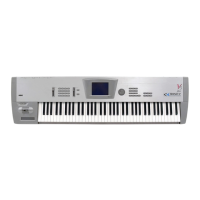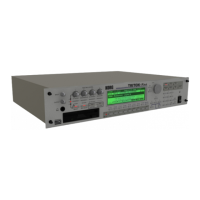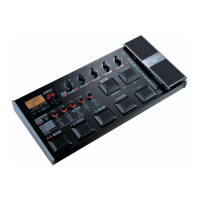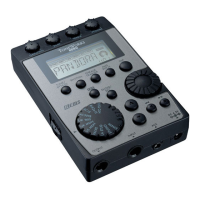1–1: Prog Basic (Program Basic)
6
If
drums
is selected, the program uses 1 oscillator as when single is selected, but a drum kit will be
used instead of a multisample for Oscillator 1.
1–1d: Assign/Hold
Assign
Mono
If Mono is
checked
, the program will be monophonic.
If Mono is
not checked
, the program will be polyphonic.
Monophonic means that the program will produce only 1 note at a time. Polyphonic means that
chords can be played.
Legato
This setting will be available only if Mono is checked.
If Legato is
checked
, the program will be single-triggered.
If Legato is
not checked
, the program will be multi-triggered.
If single triggering is used, there may be cases in which the correct pitch is not produced,
depending on the multisample and the keyboard position.
Priority
This setting will be available only if Mono is checked.
It determines which note will sound when two or more keys are pressed simultaneously.
Priority will be given to the lowest note for a setting of
Low
, to the highest note with a setting of
High
, and to the last-pressed note with a setting of
Last
.
Single Trig (Single Trigger)
This setting will be available only if Mono is not checked (i.e., for a
polyphonic
program).
If this is
checked
, repeated strikes of the same note will be sounded only after the previous note is
turned off, meaning that notes will not overlap.
Hold [On/Off]
If Hold is
checked
, Hold will be On.
If Hold is
not checked
, Hold will be Off.
When
Hold is On
, the sound will continue as though the key remained pressed even after the key
is released. Unless the “5–2 (5–4): Amp 1(2) EG” setting for Amp EG Sustain Level is set to 0, the
sound will continue sounding.
This setting is appropriate for drums, so if you have selected “drums” for “1–1c: Oscillator Mode”
you should set
Hold On
. For normal programs, set
Hold Off
.
1–1e: Scale
Type (Scale Type) [Equal Temperament…All Range User Scale]
This selects the basic scale of the internal tone generator. Settings for the User Scales can be made
in Global mode 3–1: User Scale” (
☞
page 140).
Equal Temperament
is the most commonly used scale. Each chromatic step is spaced at an equal
interval.
Pure Major
is a scale in which the principal major chords of the selected key will be perfectly in
tune.
Pure Minor
is a scale in which the principal minor chords of the selected key will be perfectly in
tune.
Arabic
is a scale that includes 1/4 tones and is used in Arabian music.
Pythagoras
is a scale derived from musical theories of ancient Greece, and is especially suitable for
melodic playing.
Werkmeister
is an equal tempered scale that was used in the later Baroque period.
Kirnberger
is a scale that was developed in the 18th century, and used mainly by harpsichords.
Slendro
is a scale which divides the octave into 5 notes, and is used in Indonesian Gamelan music.
When the Scale Key is set to C, use the notes C, D, F, G, and A. (The other keys are tuned to equal
temperament.)
Pelog
is a scale which divides the octave into 7 notes, and is used in Indonesian Gamelan music.
When the Scale Key is set to C, use the white keys. (The black keys are tuned to equal temperament.)
Octave User Scale
allows you to specify in Global mode “3–1b: Octave Notes” (
☞
page 140 in this
manual) the tuning of each note in an octave. The default setting is the scale used for combination
A054: Real Harp Gliss.
